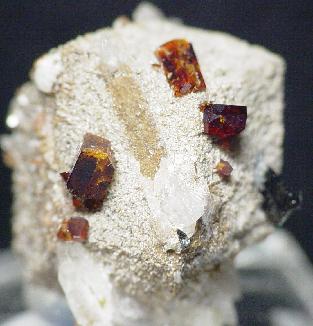The Mineral manganoneptunite

Manganoneptunite is the manganese-dominant variant of Neptunite, having a greater portion of manganese over iron in a solid solution series. Although often considered a variety of Neptunite, the IMA recognizes Manganoneptunite as a distinct mineral species. Manganoneptunite is generally ligher in color than Neptunite, and can even be completely transparent in specimens where the iron content is very low.
Chemical Formula
KNa2Li(Fe2+,Mn)2Ti2Si8O24
Color
Red, dark red, orange, brown, dark brown, black
Crystal System
Monoclinic
Properties
Streak
Dark brown |
Hardness
5 - 6 |
Transparency
Transparent to nearly opaque |
Specific Gravity
3.2 - 3.3 |
Luster
Vitreous |
Cleavage
1,1 - with 80 and 100 degree angles |
Fracture
Conchoidal |
Tenacity
Brittle |
Crystal Habits
As small tabular and prismatic crystals with a square cross-section. Also in complex crystals with many faces, and in tabular crystals with rhombic faces.
Noteworthy Localities
Manganoneptunite is not a common mineral, and is only found is a limited amount of deposits worldwide. The most notable locality for this mineral is Mont Saint-Hilaire, Québec, Canada, where small transparent, orange to dark-red crystals occur. Darker colored crystals are found nearby at the Demix-Varennes quarry, Varennes & St-Amable, Québec. Black lustrous Manganoneptunite crystals have been fround in the Aris Quarry, Windhoek District, Namibia; and black-cherry-red crystals from the Kola Peninsula in Russia.
Common Mineral Associations
Albite, Microcline, Aegirine
Distingushing Similar Minerals
Neptunite - Usually darker in color. Manganoneptunite also rarely forms in large crystals, as does Neptunite.